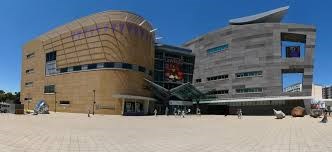The Museum of New Zealand Te Papa Tongarewa is the national museum and art gallery of New Zealand, located in Wellington. It is branded and commonly known as Te Papa and Our Place; "Te Papa Tongarewa" is broadly translatable as "the place of treasures of this land".
The museum's principles incorporate the concepts of unified collections; the narratives of culture and place; the idea of forum; the bicultural partnership between Tangata Whenua and Tangata Tiriti; and an emphasis on diversity and multidisciplinary collaboration.
The majority of exhibitions at Te Papa are free to the general public, and while the museum receives some Government funding, it is also dependent on sponsorship and donations to keep general entry free.
Like many significant buildings in Wellington, Te Papa is built on a fault line, and the construction of the museum deployed a ground-breaking (if you excuse the pun) development in earthquake mitigation, known as base-isolation.
Just outside the main entrance is an exhibit that provides information about the base isolators at Te Papa and Maori mythology related to earthquakes. Here you will find a map that shows the areas of Wellington most affected by shaking in an earthquake.
Wellington is susceptible to earthquakes because it is in a zone where two tectonic plates meet. As a result, three major fault-lines run through or very close to Wellington city: the Ōhariu Fault, the Wairarapa Fault and the Wellington Fault.
Because buildings are attached to the ground, when the ground shakes, the building shakes with it. In some cases, the upper levels of a building may shake more than the ground does. This can cause damage to the building, and may injure or kill the people inside.
You can reduce the amount of shaking that a building experiences in an earthquake by having the building "isolated" from the ground, instead of being firmly attached to the ground. This means putting something flexible between the building and the ground. This absorbs some of the shock, and changes the short, fast shake of most earthquakes into a longer, gentler one. This also means the building moves more, but more gently, so less damage occurs.
Inside the museum, on level 2, is an exhibit called "Awesome Forces", which includes an earthquake house and plenty of information about plate techtonics, and the internal construction of the earth.
Note that from 3 April 2018, Awesome Forces is no longer available, and is being replaced. The requirements for the cache have been updated
The earth consists of 4 layers: the crust, the mantle, the outer core, and the inner core.
The crust is a relatively thin shell (4km think!) largely made up of granite, which forms the basis of the land continents, and basalt, which forms the basis of the seabed.
The mantle consists of rocks rich in iron and magnesium, and these rocks are under so much pressure that they are in liquid form deep in the mantle.
The outer core consists of a mix of iron and nickel, and is permanently molten.
The inner core is mainly iron and nickel, but is solid. The pressure here is so extreme that minerals are crushed into dense forms not found on the Earth's surface, and the temperature of the core is as hot as the sun.
The Awesome Forces exhibition has a number of rock samples from the Earth's layers on display. Test how heavy each one is - it is ok to pick each one up.
To log a find on this cache, you must email the answers to the following questions to the cache owner:
- What does the ground that Te Papa is built on do in an earthquake?
- How many base isolators are underneath Te Papa?
- In Maori mythology, what is the name of the creator of earthquakes?
Please wait for confirmation from the cache owner prior to logging your find.
While you are there, why not take some time to have a look around at the other exhibitions?
Te Papa is open from 10am to 6pm, 364 days a year (closed Christmas day). You do need to enter the building to complete this cache. Like I said earlier, entry is free.
